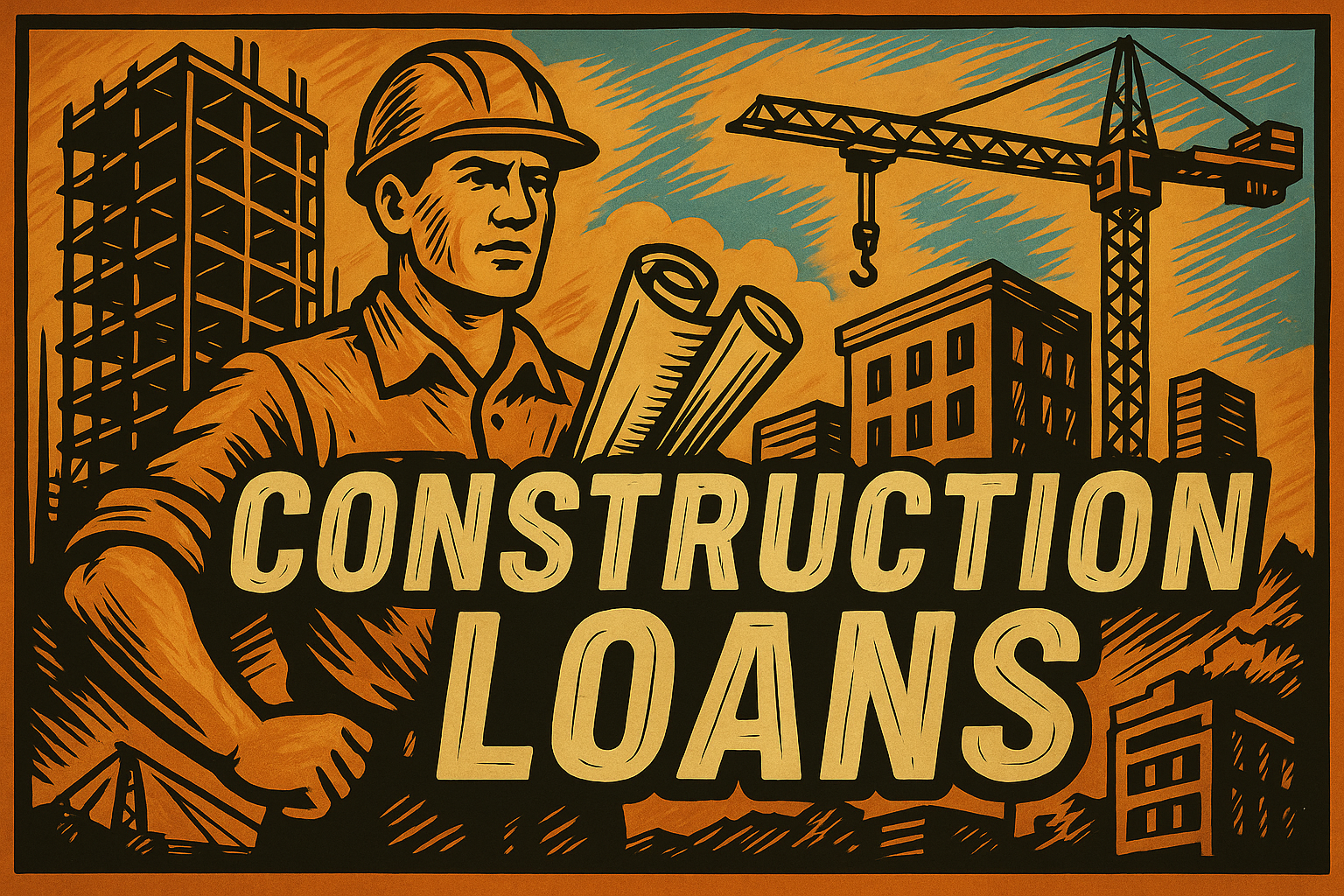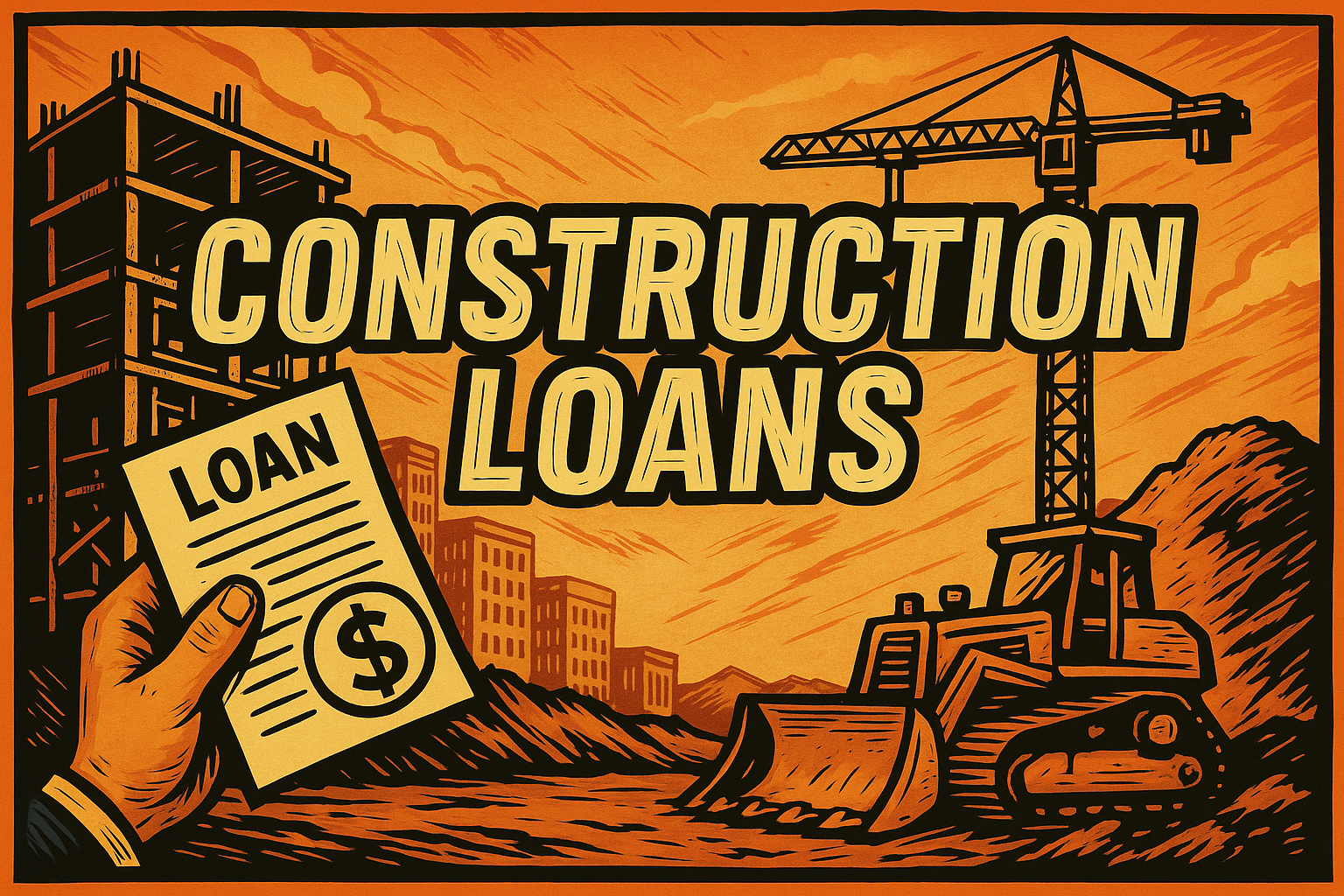Construction Loans
“Money in Phases. Progress in Stages”

Construction Loans: Fund & Build What’s Next, One Stage at a Time
A construction loan is a short-term, specialized financing tool used to fund the ground-up development, expansion, or renovation of commercial real estate. Whether you’re building an office park, upgrading a warehouse, or constructing a flagship retail location, construction loans provide the capital to get from blueprint to grand opening — in carefully timed stages.
Unlike traditional loans, these are disbursed in increments (called “draws”) as work is completed, and are typically converted into permanent financing upon project completion.
Construction Loan Characteristics
| Feature | Details |
|---|---|
| Purpose | To finance ground-up builds or major renovations of commercial properties |
| Loan Term | Short-term: usually 6–24 months |
| Disbursement | In stages (draws), based on construction milestones |
| Interest Payments | Interest-only during construction period |
| Conversion Option | Often refinanced or converted into a long-term mortgage after stabilization |
| Collateral | Typically the property under construction plus additional guarantees |
Common Use Cases
Construction loans are designed for businesses investing in physical growth through real estate, including:
🏬 New Retail Locations – storefronts, restaurants, shopping centers
🏢 Corporate Office Builds – headquarters or regional expansions
🏭 Warehouse or Industrial Construction – logistics hubs, manufacturing space
🏨 Hospitality Projects – boutique hotels, inns, and event venues
🏥 Healthcare or Medical Facilities – clinics, outpatient centers, veterinary offices
Pros and Cons
| ✔️ Pros | ❌ Cons |
|---|---|
| Tailored to match project timelines and contractor needs | Requires detailed construction plans, permits, and contractor agreements |
| Interest-only payments during the build phase | Higher interest rates than permanent financing |
| Flexibility through staged disbursement | Requires rigorous progress inspections and paperwork |
| Can convert to long-term loan after project is stabilized | Missed deadlines or budget overruns can affect funding |

What Lenders Look For:
To secure a construction loan, lenders typically want:
Detailed architectural and construction plans
Itemized budget and contractor estimates
Project timeline and milestones
Strong borrower financials or guarantees
Down payment/equity injection (see below)
Clear exit strategy — refinance, sale, or permanent occupancy
Typical Equity Requirements
| Project Type | Typical Borrower Equity |
|---|---|
| Owner-Occupied Commercial Build | 20% – 25% |
| Investment Property Development | 25% – 35% |
| Ground-Up Construction | 25% – 30%+ |
| SBA 504 Construction Project | 10% – 20% (SBA-backed) |
Note: Higher-risk projects (e.g., speculative builds or undeveloped land) may require more equity, while SBA-backed loans may allow less because of government guarantees.
What Counts Toward the Equity Injection?
Lenders may consider the following as part of your down payment or equity:
💵 Cash contribution
🏗️ Value of land (if owned, may count as equity)
📐 Pre-development costs (e.g., design, permits, surveys)
🛠️ In-kind contributions (e.g., equipment, materials — rare, must be documented and verifiable)
Why the Equity Requirement Matters
Shows borrower commitment
Buffers against cost overruns or market shifts
Ensures the borrower has “skin in the game”
Lowers loan-to-cost (LTC) ratio, making the loan more bankable
Helps qualify the project for eventual take-out financing
Example Scenarios
🏭 Example Scenario: Manufacturing Facility Expansion
Situation: A regional metal fabrication company needs to expand operations with a new 20,000 sq. ft. production facility adjacent to their current plant.
Loan Structure: $3.7 million construction loan, 14-month term, interest-only at 8.75%.
Disbursement: Five draws tied to site work (concrete slab, structural steel, interior buildout, final equipment install, and occupancy certificate).
Exit Strategy: Roll into a 20-year owner-occupied commercial real estate loan with the same lender.
Result: The business increases production capacity by 40%, meets growing demand, and gains a permanent facility with no disruption to current operations.
🏬 Example Scenario: Ground-Up Retail Center
Situation: A real estate development group is constructing a 15,000 sq. ft. retail plaza anchored by a regional coffee chain and two boutique tenants.
Loan Structure: $2.5 million construction loan, 18-month term, interest-only at 9.25%.
Disbursement: Draws scheduled by foundation, framing, roofing, tenant improvements, and final inspection.
Exit Strategy: Refinance into a long-term commercial mortgage once 90% of space is leased.
Result: The developer delivers a fully leased retail property, secures stable income, and exits the construction loan with permanent financing in place.
🏥 Example Scenario: Medical Office Buildout
Situation: A group of physicians is expanding their private practice with a new 10,000 sq. ft. outpatient clinic.
Loan Structure: $1.8 million construction loan, 12-month term, interest-only at 8.5%.
Disbursement: Four draws based on excavation, framing, interior systems, and final inspection.
Exit Strategy: Convert to a 15-year fixed-rate owner-occupied commercial real estate loan.
Result: The physicians open their new clinic on time, add diagnostic equipment, and grow patient capacity without major upfront capital.

Best Practices for Construction Loan Borrowers
Develop a Detailed Budget and Timeline
- Why it matters: Lenders disburse funds in phases based on your construction schedule and progress.
- Best practice: Create a line-item budget and Gantt-style timeline, showing clear milestones for each draw request.
Vet Your Contractors and Subcontractors
- Why it matters: Lenders may request contractor credentials, licenses, or bonding.
- Best practice: Work with reputable, experienced builders who understand the bank’s inspection and draw process.
Secure All Permits and Approvals Early
- Why it matters: Funding can be delayed if local permits (zoning, building, environmental) are incomplete.
- Best practice: Get all approvals before requesting your first draw or breaking ground.
Maintain Strong Communication with Your Lender
- Why it matters: Construction loans involve inspections, progress reports, and regular updates.
- Best practice: Assign a point person internally or from your GC (general contractor) to coordinate with the lender’s project manager or inspector.
Build in a Contingency Reserve
- Why it matters: Construction rarely goes 100% according to plan — prices change, delays happen.
- Best practice: Include a 10–15% contingency line in your budget to cover unexpected costs without halting the project.
Keep Documentation Organized and Accessible
- Why it matters: Draw requests require invoices, lien waivers, inspections, and photos.
- Best practice: Use cloud-based tools or project management software to store and share documents easily.
Avoid Scope Creep
- Why it matters: Making changes mid-project can delay schedules and lead to cost overruns.
- Best practice: Finalize your design and build plan before construction starts — and stick to it unless absolutely necessary.
Plan for the Take-Out Financing Early
- Why it matters: Construction loans usually must be paid off or refinanced after the build is complete.
- Best practice: Line up your permanent loan, sale, or exit strategy well before the project’s end date.
Monitor Draw Disbursements Closely
- Why it matters: Overdrawing or misusing funds can put your project or credit at risk.
- Best practice: Track each draw request and ensure the funds are applied to intended construction phases.
Maintain Liquidity and Good Credit
- Why it matters: Lenders may require borrower guarantees, updated financials, or re-verification during the loan.
- Best practice: Avoid major new debts during the build and keep your credit profile strong.
Final Takeaway
Construction loans are a go-to solution for turning vision into square footage. They provide short-term, milestone-based capital that bridges the gap between concept and completion — and often transition seamlessly into long-term loans. If your business is ready to grow physically, a construction loan helps you lay the foundation — literally.


